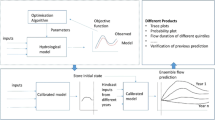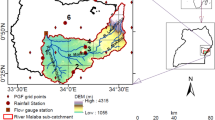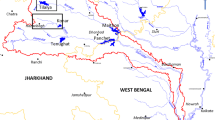Abstract
Over the past few decades, many numerical streamflow prediction techniques using observed time series (TS) have been developed and widely used in water resources planning and management. Recent advances in quantitative rainfall forecasting by numerical weather prediction (NWP) models have made it possible to produce improved streamflow forecasts using continuous rainfall-runoff (RR) models. In the absence of a suitable integrated system of NWP, RR and river system models, river operators in Australia mostly use spreadsheet-based tools to forecast streamflow using gauged records. The eWater Cooperative Research Centre of Australia has recently developed a new generation software package called eWater Source, which allows a seamless integration of continuous RR and river system models for operational and planning purposes. This paper presents the outcomes of a study that was carried out using Source for a comparative evaluation of streamflow forecasting by several well-known TS based linear techniques and RR models in two selected sub-basins in the upper Murray river system of the Murray-Darling Basin in Australia. The results were compared with the actual forecasts made by the Murray River operators and the observed data. The results show that while streamflow forecasts by the river operators were reasonably accurate up to day 3 and traditional TS based approaches were reasonably accurate up to 2 days. Well calibrated RR models can provide better forecasts for longer periods when using high quality quantitative precipitation forecasts. The river operators tended to underestimate large magnitude flows.






Similar content being viewed by others
Abbreviations
- ACCESS:
-
Australian Community Climate and Earth-System Simulator
- ANN:
-
Artificial Neural Networks
- AR:
-
Auto-Regressive
- ARIMA:
-
Auto-Regressive Integrated Moving Average
- ARMA:
-
Auto-Regressive Moving Averages
- ARMAX:
-
ARMA model with exogenous or independent variables
- AWBM:
-
Australian Water Balance Model
- BoM:
-
Australian Bureau of Meteorology
- CRC:
-
Cooperative Research Centre
- CSIRO:
-
The Commonwealth Scientific and Industrial Research Organisation
- DLL:
-
Dynamically Linked Library
- GR4J:
-
Modele du Genie Rural a 4 parametres journalier
- IHACRES:
-
Instantaneous unit Hydrograph And Component flows from Rainfall, Evapotranspiration and Streamflow data
- IQQM:
-
Integrated Quantify and Quality Model
- MAE:
-
Mean Absolute Error
- MAPE:
-
Mean Absolute Percentage Error
- MDB:
-
Murray-Darling Basin
- MDBA:
-
Murray-Darling Basin Authority
- MSM:
-
Monthly Simulation Model
- NMOC:
-
National Meteorological and Oceanographic Centre
- NSE:
-
Nash-Sutcliffe Efficiency co-efficient
- NWP:
-
Numerical Weather Prediction
- QPF:
-
Quantitative Precipitation Forecasts
- R2:
-
Coefficient of Determination
- REALM:
-
Resource Allocation Model
- RM:
-
River Manager
- RO:
-
River Operator
- RR:
-
Rainfall-Runoff
- SILO:
-
Spatialised Information for Landholders and Organisations
- SIMHYD:
-
Simplified HYDROLOG
- SMARG:
-
Soil Moisture Accounting and Routing Model
- TIME:
-
The Invisible Modelling Environment
- TS:
-
Time Series
- WBE:
-
Water Balance Error
- WIRADA:
-
Water Information Research and Development Alliance
References
Akaike H (1973) Information Theory and an Extension of the Maximum Likelihood Principle. 2nd International Symposium on Information Theory, Akademia Kiado, Budapest, pp. 267–281
Anderson ML, Chen Z-Q, Kavva ML, Feldman A (2002) Coupling HEC-HMS with atmospheric models for prediction of watershed Runoff. J Hydrol Eng 7(3):312–318
Andréassian V, Perrin C, Michel C, Iolanda US, Lavabre J (2001) Impact of imperfect rainfall knowledge on the efficiency and the parameters of watershed models. J Hydrol 250:206–223
Argent RM, Perraud J-M, Rahman JM, Grayson RB, Podger GM (2009) A new approach to water quality modelling and environmental decision support systems. Environ Model Softw 24(7):809–818
Awwad HM, Valdes JB (1992) Adaptive parameter estimation for multisite hydrologic forecasting. ASCE J Hydraul Eng 118(9):1201–1221
Awwad HM, Valdes JB, Restrepo PJ (1994) Streamflow forecasting for Han River basin, Korea. ASCE J Water Resour Plan Manag 120(5):651–673
Barrett DJ, Kuzmin VA, Walker JP, McVicar TR, Draper C (2008) Improving stream flow forecasting by integrating satellite observations, in situ data and catchment models using model-data assimilation methods. eWater Technical Report, eWater Cooperative Research Centre, Canberra 59p
BoM (2009) NMOC Operations Bulletin No. 78. Bureau of Meteorology, Australian Government 6p
BoM (2010) Operational implementation of the ACCESS Numerical Weather Prediction systems. NMOC Operations Bulletin No. 83, Bureau of Meteorology, Australian Government 34p
Boughton WC (2004) The Australian water balance model. Environ Model Softw 19:943–956
Bowerman BL, O’Connell RT (1993) Forecasting and Time Series: an applied approach. Wadsworth, Inc. Third Ed
Box GEP, Jenkins GM (1970) Time series analysis forecasting and control. Holden-Day, San Fracisco
Box GEP, Pierce DA (1970) Distribution of the residual autocorrelations in autoregressive-integrated moving average time series models. J Am Stat Assoc 65:1509–1526
Burnash RJC, Ferral RL, McGuire RA (1973) A generalised streamflow simulation system—Conceptual modelling for digital computers. Joint Federal and State River Forecast Center, Sacramento, Technical Report, 204 pp
Cerlini PB, Emanuel KA, Todini E (2005) Orographic effects on convective precipitation and space-time rainfall variability: preliminary results. Hydrol Earth Syst Sci 9:285–299
Chiew FHS, Peel MC, Western AW (2002) Application and testing of the simple rainfall-runoff model SIMHYD. In: Singh VP, Frevert DK (eds) Mathematical models of small watershed hydrology and applications. Water Resources Publications, Littleton, pp 335–367
Clark M, Hay LE (2004) Use of medium-range numerical weather prediction model output to produce forecasts of streamflow. J Hydrometeorol 5:15–32
Close AF (1996) The BIGMOD model of flow in the River Murray. MDBC Technical Report 96/12. Murray-Darling Basin Commission, Canberra.
Collischonn W, Haas R, Andreolli I, Tucci CEM (2005) Forecasting River Uruguay flow using rainfall forecasts from a regional weather-prediction model. J Hydrol 205:87–88
Cortez P, Rocha M (2004) Evolving time series forecasting ARMA models. Kluwer Academic Publishers, Netherlands, 25p
Croke BFW, Andrews F, Jakeman AJ, Cuddy SM, Luddy A (2006) IHACRES Classic Plus: a redesign of the IHACRES rainfall-runoff model. Environ Model Softw 21:426–427
CSIRO (2008) Water availability in the ovens, A report to the Australian Government from the CSIRO Murray-Darling Basin Sustainable Yields Project. CSIRO, Australia, 100 p
Cuo L, Pagano T (2011) A review of quantitative precipitation forecasts and their Use in short- to medium-range streamflow forecasting. J Hydrometeorol. doi:10.1175/2011JHM1347.1
Demeritt D, Cloke H, Pappenberger F, Thielen J, Bartholmes J, Ramos M-H (2007) Ensemble predictions and perceptions of risk, uncertainty and error in flood forecasting. Environ Hazards 7(2):115–127
Duan QY, Gupta VK, Sorooshian S (1993) Shuffled complex evolution approach for effective and efficient global minimization. J Optimiz Theory Appl 76(3):501–521
Dutta D, Herath S, Musiake K (2000) Flood inundation simulation in a river basin using a physically based distributed hydrologic model. Hydrol Process 14(3):497–520
Dutta D, Alam J, Umeda K, Hayashi M, Hironaka S (2007) A two dimensional hydrodynamic model for flood inundation simulation: a case study in the Lower Mekong River basin. Hydrol Process 21:1223–1237
Ebert EE, McBride JL (2000) Verification of precipitation in weather systems: determination of systematic errors. J Hydrol 239:179–202
eWater (2011) How to write a Source plugin. eWater CRC, Canberra, 4th July 2011, 46 pp
Frausto-Solis J, Pita E, Lagunas J (2008) Short-term streamflow forecasting: ARIMA vs Neural Networks. American Conference on Applied Mathematics (MATH '08), Harvard, Massachusetts, USA, pp 402–407
George B, Adams R, Ryu D, Western AW, Simon P, Nawarathna B (2011) An Assessment of Potential Operational Benefits of Short-term Stream Flow Forecasting in the Broken Catchment, Victoria, Proceedings of the 34th IAHR World Congress, Brisbane, Australia
Ghile YB, Schulze RE (2010) Evaluation of three numerical weather prediction models for short and medium range agrohydrological applications. Water Resour Manag 24(5):1005–1028
Golding BW (2000) Quantitative precipitation forecasting in the UK. J Hydrol 239:286–305
Gouweleeuw BT, Leahy GP, Weerts AH (2009) Quantitative precipitation forecast and early warning: the Hunter Valley flood of June 2007, 18th World IMACS/MODSIM Congress, Cairns, Australia, pp. 3711–3717
Jeffrey SJ, Carter JO, Moodie KB, Beswick AR (2001) Using spatial interpolation to construct a comprehensive archive of Australian climate data. Environ Model Softw 16:309–330
Kaufmann P, Schubiger F, Binder P (2003) Precipitation forecasting by a mesoscale numerical weather prediction (NWP) model: eight years of experience. Hydrol Earth Syst Sci 7:812–832
Kim SB, Kim BK, Kim HS (2008) Flood simulation using the gauge-adjusted radar rainfall and physics-based distributed hydrologic model. Hydrol Process 22:4400–4414
Kim SSH, Dutta D, Singh R, Chen J, Welsh WD (2011) Providing flexibility in GUI-based river modelling software—Using plug-ins to create Custom Functions in Source IMS. Proceedings of the MODSIM 2011 International Congress on Modelling and Simulation, 12–16 December 2011, Perth, Australia pp 2345–2351
Koussis AD, Lagouvardos K, Mazi K, Kotroni V, Sitzmann D, Lang J, Zaiss H, Buzzi A, Malguzzi P (2003) Flood forecasts for urban basins with integrated hydro-meteorological model. J Hydrol Eng 8(1):1–11
Kuzmin VA, Seed AW, Walker JP (2007) Australian Government Bureau of Meteorology forecast and real-time observational hydro-meteorological data for hydrologic forecasting. eWater Technical Report, 29 p
Mohammadi K, Eslami HR, Kahawita R (2006) Parameter estimation of an ARMA model for river flow forecasting using goal programming. J Hydrol 331:293–299
Mohan S, Vedula S (1995) Multiplicative seasonal Arima model for longterm forecasting of inflows. Water Resour Manag 9(2):115–126
Moriasi DN, Arnold JG, Van Liew MW, Bingner RL, Harmel RD, Veith TL (2007) Model evaluation guidelines for systematic quantification of accuracy in watershed simulations. Am Soc Agric Biol Eng 50(3):885–900
Nash JE, Sutcliffe JV (1970) River flow forecasting through conceptual models, I, A discussion of principles. J Hydrol 10:282–290
Newbold P (1981) Some recent developments in time series analysis. Int Stat Rev 49:53–66
Parliament of Victoria (1992) Heritage Rivers Act, version No. 014 incorporating amendments as at 7 December 2007, 33 p
Perera BJC, James B, Kularathna MDU (2005) Computer software tool REALM for sustainable water allocation and management. J Environ Manag 77:291–300
Perrin C, Michel C, Andreassian V (2003) Improvement of a parsimonious model for streamflow simulations. J Hydrol 279:275–289
Rahman JM, Seaton SP, Perraud J-M, Hotham H, Verrelli DI, Coleman JR (2003) It’s TIME for a new environmental modelling framework. MODSIM 4:1727–1732
Rosenbrock HH (1960) An automatic method for finding the greatest or least value of a function. Comput J 3:175–184
Simons M, Podger G, Cooke R (1996) IQQM—A hydrologic modelling tool for water resource and salinity management. Environ Softw 11(1–3):185–192
Sprave J (1994) Linear neighborhood evolution strategy. 3rd Annual Conference on Evolutionary Programming, World Scientific, Singapore, pp. 42–51
Tang Z, Almeida C, Fishwick PA (1991) Time series forecasting using neural networks vs. Box-Jenkins methodology. Simulation 303–310
Teng J, Chiew FHS, Vaze J, Post DA (2011) Calibration of hydrological models for medium-term streamflow prediction in a changing climate. Hydro-climatology: Variability and Change Symposium, IUGG2011, IAHS Publication 344. IAHS Press, Wallingford, UK
Tucci CEM, Collischonn W (2006) Flood forecasting. WMO Bull 55(3):179–184
Vaze J, Barnett P, Beale GTH, Dawes W, Evans R, Tuteja NK, Murphy B, Geeves G, Miller M (2004) Modelling the effects of landuse change on water and salt delivery from a catchment affected by dryland salinity in south-east Australia. Hydrol Process 18:1613–1637
Vaze J, Post DA, Chiew FHS, Perraud J-M, Viney N, Teng J (2010) Climate nonstationarity—Validity of calibrated rainfall-runoff models for use in climate change studies. J Hydrol 394:447–457
Vaze J, Chiew FHS, Perraud J-M, Viney N, Post DA, Teng J, Wang B, Lerat J, Goswami M (2011a) Rainfall-runoff modelling across southeast Australia: datasets, models and results. Aust J Water Resour 14(2):101–116
Vaze J, Post DA, Chiew FHS, Perraud J-M, Viney N, Teng J (2011b) Effect of input rainfall data and spatial modelling on rainfall runoff model performance and optimised parameter values. J Hydrometeorol. doi:10.1175/2011JHM1340.1
Vaze J, Davidson A, Teng J, Podger G (2011c) Impact of climate change on water availability in the Macquarie–Castlereagh river basin in Australia. Hydrol Process 25(16):2597–2612. doi:10.1002/hyp. 8030
Vicens G, Rodriquez-Iturbe I, Schaake T (1975) A Bayesian framework for the use of regional information in hydrology. Water Resour Res 11(3):405–415
Viney NR, Perraud J-M, Vaze J, Chiew FHS, Post DA, Yang A (2009) The usefulness of bias constraints in model calibration for regionalisation to ungauged catchments. 18th World IMACS / MODSIM Congress, Cairns, Australia
Wang W, van Gelder P, Vrijling JK (2005) Improving Daily Stream Flow Forecasts by Combining ARMA And ANN Models. International conference on innovation advances and implementation of flood forecasting technology, Norway, 1–13
Welsh W, Vaze J, Dutta D, Rassam D, Rahman J, Jolly I, Wallbrink P, Podger G, Bethune M, Hardy MJ, Teng J, Lerat J (2012) An integrated modelling framework for regulated river systems. Environ Model Softw. doi:10.1016/j.envsoft.2012.02.022
Wu X (2010) Quarterly numerical weather prediction model performance summary October to December 2009. Aust Meteorol Oceanogr J 60:87–90
Acknowledgement
The following are greatly acknowledged for their contributions:
• Andrew Bishop, MDBA, for the Murray River system operators’ spreadsheets,
• Tom Pagano, CSIRO, for NWP data from WIRADA project and
• Kerrie Tomkins and Mohammed Mainuddin, CSIRO, for some very insightful review comments.
Author information
Authors and Affiliations
Corresponding author
Rights and permissions
About this article
Cite this article
Dutta, D., Welsh, W.D., Vaze, J. et al. A Comparative Evaluation of Short-Term Streamflow Forecasting Using Time Series Analysis and Rainfall-Runoff Models in eWater Source. Water Resour Manage 26, 4397–4415 (2012). https://doi.org/10.1007/s11269-012-0151-9
Received:
Accepted:
Published:
Issue Date:
DOI: https://doi.org/10.1007/s11269-012-0151-9




